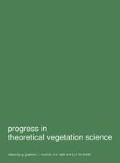Abstract
A new dissimilarity measure, Uppsala dissimilarity, is proposed. It is a Manhattan-type measure in between the Canberra and Gower measures, based on the differences between scores in relevés compared, but it also takes both the sums of scores and the difference between maximum and minimum score into account. The measure is considered realistic for phytosociological material.
A new optimality criterion has been developed after unsatisfactory results had been obtained with the DOL criterion (Popma et al. 1983) which was developed previously by our group. Problems with DOL were especially met when the criterion was applied to the distribution of only one species over the cluster array obtained. The new criterion takes both internal cluster homogeneity and between-cluster dissimilarity into account. Between-cluster dissimilarity is calculated for all other clusters and not only for the nearest neighbour, as in DOL. The new criterion has both an unweighted form: SOM, and a form with weighting for cluster size: SWOM.
This new criterion was successfully applied to the evaluation of the sharpness of distribution of individual species over cluster arrays, under the name of SIM: species indication measure and SWIM, species weighted indication measure.
The measures were applied to some test data. Differences between the unweighted and weighted forms were found which could not be easily interpreted.
Some remarks are made on the coherence of d-SAHN and h-SAHN approaches in agglomerative clustering within the new strategy proposed.
Access this chapter
Tax calculation will be finalised at checkout
Purchases are for personal use only
Preview
Unable to display preview. Download preview PDF.
Abbreviations
- DOL:
-
Detection of Optimal Level
- S(W)IM:
-
Species (Weighted) Indication Measure
- S(W)OM:
-
Standardized (Weighted) Optimality Measure
- UD:
-
Uppsala Dissimilarity measure
- WPGMA:
-
Weighted Pair-Group Method Average linking clustering
- SAHN:
-
Sequential Agglomerative Hierarchical Non-overlapping clustering
References
Beals, E. W. 1984. Bray Curtis ordination: an effective strategy for analysis of multivariate ecological data. Adv. Ecol. Res. 14: 1–55.
Digby, P. G. N. & Kempton, R. A. 1987. Multivariate analysis of ecological communities. Chapman and Hall, London.
Faith, D. P. 1984. Patterns of sensitivity of association measures in numerical taxonomy. Math. Biosci. 69: 199–207.
Faith, D. P., Minchin, P. R. & Beibin, L. 1987. Compositional dissimilarity as a robust measure of ecological distance. Vegetatio 69: 57–68.
Feoli, E. & Lausi, D. 1980. Hierarchical levels in syntaxonomy based on information functions. Vegetatio 42: 113–115.
Gauch Jr, H. G. 1982. Multivariate analysis in community ecology. Cambridge University Press, Cambridge.
Gower, J. C. 1971. A general coefficient of similarity and some of its properties. Biometrics 23: 623–637.
Greig-Smith, P. 1983. Quantitative plant ecology. 3rd. ed. Blackwell, Oxford.
Hill, M. O., Bunce, R. G. H. & Shaw, M. W. 1975. Indicator species analysis, a divisive polythetic method of classification, and its application to a survey of native pinewoods in Scotland. J. Ecol. 63: 597–613.
Hogeweg, P. 1976. Iterative character weighting in numerical taxonomy. Comp. Biol. Med. 6: 199–211.
Jongman, R. H. G., ter Braak, C. J. F. & van Tongeren, O. F. R. 1987. Data analysis in community and landscape ecology. Pudoc, Wageningen.
Legendre, L. & Legendre, P. 1983. Numerical ecology. Elsevier, Amsterdam.
Ludwig, J. A. & Reynolds, J. F. 1988. Statistical ecology. Wiley, New York.
Noest, V., van der Maarel, E., van der Meulen, F. & van der Laan, D. 1989. Optimum-transformation of plant species cover-abundance values. Vegetatio 83: 167–178.
Pielou, E. C. 1984. The interpretation of ecological data. A primer on classification and ordination. Wiley, New York.
Podani, J. 1989. New combinatorial cluster methods. Vegetatio 81: 61–77.
Popma, J., Mucina, L., van Tongeren, O. F. R. & van der Maarel, E. 1983. On the determination of optimal levels in phytosociological classification. Vegetatio 52: 65–75.
Ratliff, D. & Pieper, R. D. 1981. Deciding final clusters: An approach using intra- and intercluster distances. Vegetatio 48: 83–86.
Sneath, P. H. A. & Sokal, R. R. 1973. Numerical taxonomy. Freeman, San Francisco.
van der Maarel, E. 1979a. Transformation of cover-abundance values in phyto sociology and its effects on community similarity. Vegetatio 39: 97–114.
van der Maarel, E. 1979b. Multivariate methods in phytosociology, with reference to the Netherlands. In: Werger, M. J. A. (ed.), The study of vegetation, pp. 163–225. Junk, The Hague.
van der Maarel, E., Janssen, J. G. M. & Louppen, J. M. W. 1978. TABORD, a program for structuring phytosociological tables. Vegetado 38: 143–156.
Ward, J. H. 1963. Hierarchical grouping to optimize an objective function. J. Amer. Statist. Ass. 58: 236–244.
Wishart, D. 1978. Clustan users manual, 3rd ed. Edinburgh University, Edinburgh.
Author information
Authors and Affiliations
Editor information
Rights and permissions
Copyright information
© 1990 Kluwer Academic Publishers
About this chapter
Cite this chapter
Noest, V., van der Maarel, E. (1990). A new dissimilarity measure and a new optimality criterion in phytosociological classification. In: Grabherr, G., Mucina, L., Dale, M.B., Ter Braak, C.J.F. (eds) Progress in theoretical vegetation science. Advances in vegetation science, vol 11. Springer, Dordrecht. https://doi.org/10.1007/978-94-009-1934-1_13
Download citation
DOI: https://doi.org/10.1007/978-94-009-1934-1_13
Publisher Name: Springer, Dordrecht
Print ISBN: 978-94-010-7363-9
Online ISBN: 978-94-009-1934-1
eBook Packages: Springer Book Archive

